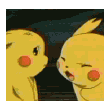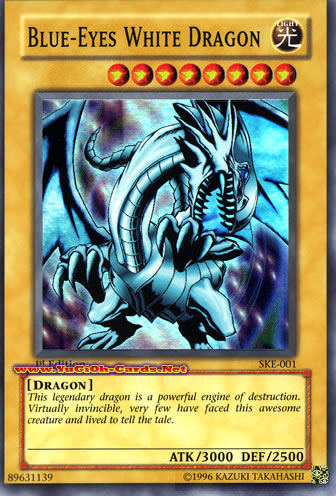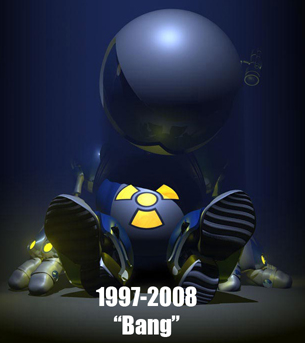While I initially intended to discuss the difference between Shonen and Shoujo art styles, I realized my last post missed a rather important chapter of anime's assimilation into America's cultural consciousness: The Monster Plagues. From 1998 to around 2003, America was wracked by Japanese monster collecting franchises. Nobody knows advertising and merchandising like the 日本人, particularly because there is a social element to it. Popular fiction is designed with a sort of brand recognition in mind, blending consumerism and cultural consciousness in a way that would send George Lucas to the Sepuku Mat with shame. America's youth got a taste of this with the Power Ranger craze that came in the mid 90's, although the franchise was rebuilt from scratch in the USA for the USA, and merely based on the Japanese concept of Sentai. Even earlier than that, Transformers demonstrated the lucrative potential of using a cartoon to market toys.
You used the Multimedia stone! What...!? Mickey is evolving!

Congratulations! Your Mickey evolved to Pikachu!
The monster plagues are significant because they represent the first time foreign fictional universes were marketed towards children across a broad spectrum of socially interactive media. Disney has been doing cross-marketting for years, threading Saturday morning cartoons through coloring books, breakfast cereals and happy meals, but they were completely out-classed by the monster collecting menaces which emphasized fan interactivity at every corner. The card and video games were set up to require trading while the manga and anime brought the world behind the games to life.
The First Plague

I first learned about 'Pocket Monsters', or pokemon (lower case refers to the critters, uppercase refers to the franchise.) through an advertising video which arrived on my doorstep. I'm not sure if it was connected to my Nintendo Power subscription, or dropped off by some shady division of the JSDF which had profiled me as an easy target, but the tape captivated me immediately, introducing a bright and friendly world populated with adorable, elementally powered creatures just waiting to be collected in shiny metal balls.
I faithfully watched the anime when it came out, which furthered my indoctrination with insidiously catchy marketing jingles that taught me to memorize each one of the 150 critters names. The Anime, which is apparently still running to my great astonishment and slight horror, follows the adventures of Ash Ketchum and series mascot pikachu as they casually foil the plans of incompetent villains known as team rocket, try to catch 'em all and aspire to be "the very best, like no one ever was," (Click at your own risk, there is more singing).
This was all a preamble to the video game of course, which I pre-ordered and devoured upon arrival, eager to show off all my cartoon gained knowledge. The true evil genius behind the pokemon marketing strategy is that a player couldn't catch all the monsters by playing just a single version of the game. Rather, all the games critters were divided between a two versions of the game, and players were required to trade in order to collect all the creatures. Fortunately, a friend in grade school picked out the blue version to my red version, and we slowly mannaged to fill out our entire pokedex.
 It was going to see the movie which really did in my parents' patience, prompting my father to point out "This is really sick." And so it is. Beneath the bright colors and adorable creature designs, Pokemon is really quite dark. You play the role of a pre-adolescent delinquent who wanders around assaulting, abducting and brainwashing animals that pose no apparent threat to society, all for the sake of casually pitting them against each other in gladiatorial combat. It was a truth I rejected when my parents first presented it to me, using dog fighting as the real world analogy. It seemed like hyperbolic comparison, but back then I could not articulate where they were crossing the line.
It was going to see the movie which really did in my parents' patience, prompting my father to point out "This is really sick." And so it is. Beneath the bright colors and adorable creature designs, Pokemon is really quite dark. You play the role of a pre-adolescent delinquent who wanders around assaulting, abducting and brainwashing animals that pose no apparent threat to society, all for the sake of casually pitting them against each other in gladiatorial combat. It was a truth I rejected when my parents first presented it to me, using dog fighting as the real world analogy. It seemed like hyperbolic comparison, but back then I could not articulate where they were crossing the line.The trouble is, there is no real world reference for Pokemon, because it is a completely fabricated experience. In the real world, you can't transform something evil into something good or even something acceptable through presentation alone. In fact, trying to dress up the facts in a misleading way tends to compound its evil, especially in fields of Law (Hi Mom!) and Science (Hi Dad!). But video games are not reality.
Presentation establishes the laws of fictional universes. Series creator Satoshi Tajiri-Oniwa did not design Pokemon with animal duels in mind, but rather his hobby of collecting insects. Unfortunately, bug collecting is fairly uninteresting as a game because the only possible outcomes would be "You catch the bug!" and "The Bug got away!" In order to spice things up a bit, a rock-paper-scissors style combat system was implemented to add some depth to the creatures being collected, and the game play itself. The game is actually designed very specifically to punish excessive force (If you knock out the pokemon while trying to weaken it, you can't capture it), and to render violence inconsequential through healing items. It's not a formula which would work in real life, which is why its so pleasing as a game.
Fact vs. Fiction


The idea of inconsequential violence is alarming to a lot of people and for good reason: It's a concept which cannot exist in reality. The great fear is that players will start applying their experiences of these fictional places as if they were life lessons. It is not a baseless concern, though it is one that is frequently exaggerated when it can just as easily be overcome with some guidance and self restraint. My parent's realized this, so they let me keep playing but made sure I did other more necessary things at the same time.
My interest in Pokemon waned quickly however, mostly because I exhausted myself trying to navigate an untranslated import copy of Pokemon Gold after catching all 151 of the Red and Blue bastards, but also because I was bothered by the real world parallel that had been drawn between my favorite past-time and animal abuse. I knew bloodlust was not the driving force behind my monster collecting endeavors, but at the same time I didn't know what was. Looking back, I think the potential for discovery was another element in pokemon I found deeply appealing. Recess and afternoons playing in the back yard frequently meant pretending I was a pokemon trainer, though rather than imagining battles, I spent a great deal of time filling in the gaps of the game's world. How do Pokeballs work exactly? Are all animals in the Pokemon world pokemon? Are ghost-type pokemon born from dead people or dead pokemon? These are the sort of mundane details I am loathe to learn about reality, but utterly fascinated by when they pertain to a completely fabricated universe. Sadly, Pokemon simply walked away from all these questions.
Another huge element of appeal for Pokemon, and all the other monster combat collection series out there is the sense of having some secret knowledge. Considering how many things adults have mastery over, (Sex, Money, Cultural References, Professional knowledge) knowing about something parents have no hope of understanding is absolute bliss. It's even better when your friends don't know about it either. And for a good year or two, Pokemon was a fairly silent phenomenon. Once it was busted wide open, the appeal started to fade.
The Second Plague

Consequently, I shifted my focus toward Digimon, the next monster based anime card/video game property to hit the states. When I first heard of it, I was a rabid pokemaniac and I condemned it as a blatant ripoff based on the title, which is supposed to be short for 'Digital Monsters'. Apparently, most other kids drew the same conclusion and paid no further head to Bandai's take on monster collection. Digmon was never as popular as pokemon, which is sad, because its stories were a great deal more interesting.
I realized this when I actually watched the show and discovered it delved into many of Pokemon's disregarded questions. The story in the first season is still totally formulaic, but it actually bothers to explain how and why a bunch of brats are wandering through a dangerous world filled with monsters instead of attending school; a persistent logical blackhole in Pokemon's narrative. Another narrative boon is that the monsters are capable of human speech, unlike pokemon who can only say their names: a cute gimmick to begin with, but one that wears thin quickly. Furthermore, battles between digimon were generally necessary for survival as opposed to electively enslaving innocent creatures. Finally digital monsters had a much wider aesthetic range than psuedo-Sanrio appearance of pokemon, and occasionally managed to look somewhat bad ass.

Things really got interesting in the show's third season when it went all meta on itself, placing the story in the real world and referring to the events of the first two seasons as a TV show. Even though this shift was primarily intended to accommodate the new card game aspect of the franchise and advertise it to viewers, it was also a sound move narrative. The heroes had already saved the digital world (in the first season) and the real world (second season) so the change of pace was welcome. The question it posed to young viewers, "What if your favorite cartoon franchise became real?" invites an awesome story, though I honestly have no idea how it turned out. I had finally built up an immunity to all Mon-suffixed strains of monster plagues. It's worth mentioning that Digimon's video game properties, at least the ones I played, were inferior to the Pokemon franchise in terms of presentation and actual enjoyable game play.
The Third Plague
At some point, I was fascinated by YuGiOh! which was the first trend I ever predicted. When I inquired about an untranslated manga a thai classmate of mine was reading, he explained it was a "Card game comic book" and let me take a look. The monster designs alone told me it would be a hit: even more than Digimon, the monsters actually looked monstrous. About two years later, Kids WB brought the anime over, and the TCG (trading card game) started popping up on local shelves.
I dove into the card game excitedly, hoping to fill the card-game void within my heart that neither Magic: The Gathering, or The Pokemon TCG had been able to fill. It was then that I concluded card games are inherently evil. They are a bastion of hope for kids who can't afford to play video games, as a starter pack costs about half as much as a new top shelf console title, and the booster packs are just the right price for blowing one's allowance on, though ultimately, you end up spending about as much money on the cards as you would on a gaming system and a couple of titles. What's worse, the cards are next to useless unless you know somebody else who plays the game. If you do know somebody, it's even odds that he's an expert, or that they're just as clueless as you are. Even if you do get a feel for the game, and build a deck you're satisfied with, it will probably be rendered useless by the next batch of cards which come out. Then again, the cards do feature some very nice artwork, with creatures whose detail surpasses any pokemon or digimon I've ever seen.

The narrative frame for YuGiOh! presents the card game as a modern take on an ancient game played by the Pharoahs of Egypt, though Wikipedia can probably tell you more than I can. I only caught the show a couple of times, and then only in it's first iteration. Like Dragon Ball, YuGiOh! has spawned an alphabet soup of other series set after it. From what I saw of the first version, the main character, Yugi, wears a magic puzzle around his neck which essentially puts him through puberty when he solves it, and has a ridiculously powerful five-carded monster that results in automatic victory if he draws it and...that's pretty much it. The character designs struck me as an awkward mix of too much style and not enough complexity, and even more than pokemon, the story is relentlessly faithful to the flow of the game battles.
When I concluded my last post, I mentioned that there was some debate about what constitutes anime, and whether it has gone mainstream as an art form. I have heard fellow anime fans argue, that series like Pokemon, YuGiOh and Digimon do not count as anime series at all, because they were series designed with globalization in mind from the start. It's an interesting position, but a weak one, since the shows all follow a decidedly Japanese aesthetic (picture below explains what I mean), and served as the gateway anime to many a young viewer. Not everybody was lucky enough to catch Toonami after all. The series may be heavily edited by localization, but there are occassionaly some good reasons for such cuts. (Again see below.)

Various strains and mutations of the Monster Plagues still exist to this day, and I suspect that they shall endure for many generations to come, as poxes tend to do.












